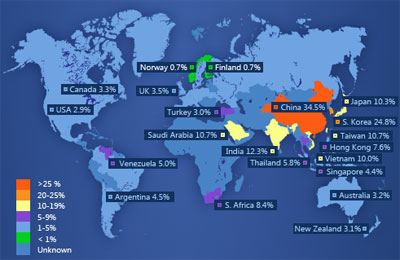Microsoft Promoting the Death of IE6

That map above shows, as of February 28, 2011, the level of Internet Explorer 6 usage around the world. What’s interesting is that this map was produced by Microsoft. This map is also (stolen by me) from a Microsoft site that is trying to move people off Internet Explorer 6, ostensibly on to Internet Explorer 8 or 9.
The site ie6countdown.com was unknown to me until today when I discovered it thanks to a tweet from @IE (Microsoft’s Internet Explorer account) promoting it:
Interestingly, perhaps only to me, this tweet is exactly one year later than the surprisingly highly-publicized IE6 funeral (it supposedly died on March 1): RIP IE6 (Not Really, But Here’s to Hoping). That people want to see IE6 go away is hardly news. You can read some of the history of companies and applications dropping support for IE6 by following the “IE6 must die” tag on Mashable articles. Sites like the obviously-named ie6nomore.com and ie6death.com have been pushing for these even longer. In fact, you can trace the history of the call for the demise of IE6 to the first breaths of IE7, sooner if you were a web developer.
While Microsoft is certainly hoping people will stop using IE6, and while the rest of us hope that people will also stop using IE7 (at least), there are still many users who have little or no choice in the matter. So many organizations built internal applications that rely on IE6 that upgrading the browser company-wide has a huge cost impact in everything from re-writing their applications to spikes in help desk requests. That employees cannot surf their local community not-for-profit site that inexplicably blocks IE6/7 is of little concern to IT managers.
What offends me about th ie6countdown site is how it promotes the use of an IE conditional comment to tell IE6 users to upgrade, something that may validate the existing terrible practice many developers have of trying to push users to the developer’s favorite browser. However, since it only affects IE6 users and may help them take the necessary steps to upgrade, it has merit. Whether it makes their IT departments do so is another story.
Before you get too self-congratulatory about how much you used to despise IE6, take a look at this contextual view of IE6 back when it first launched, written by a Microsoft staffer: Presenting IE6 with the Lifetime Achievement Award. The title may seem a little too much like he’s freebasing the Kool-Aid, but there is some good content presented in the context of 2001, including a screen shot of Netscape 6, my preferred browser at the time. If you want more history, go read Microsoft’s history of Internet Explorer (I wish they would include the add-on to Microsoft Word that let you surf from the comfort of your word processor).
Much as I’d love to segue into the upcoming IE9 and where it stands, I’d rather this post solely be yet another (and hopefully last) memorial for IE6. That and I have to get to a meeting…
Update: 2:51pm
I came back from my meeting to find that Microsoft has a blog post about this very topic (announcements put it 2 minutes after my blog post): Counting Down Internet Explorer 6 Usage Share. In the post Microsoft acknowledges the IE6 funeral, talks about the olden days of IE6, and promotes the demise of IE6 — at least down to 1% market share. There is one statement for which I wish they had provided a link:
We know that many IE6 users are on the older browser because it’s at their workplace. We’ve put together some resources for IT pros to help understand the business value of moving off IE6 and are delivering to them the tools to help them navigate the process.
A link to those resources would have been handy. Microsoft should take advantage of anyone reading its post who might need those links by allowing them to get to those resources immediately.
Later in the same post is a link to theie6countdown.com. Note the addition of “the” to the address. Apparently both work and answer separately at each address. Microsoft is costing its plan for the end of IE6 some valuable link juice.
Update: March 5, 2011
Bruce Lawson asks a very good question in the post The mystery of Microsoft IE6countdown.com — why can’t Microsoft just make IE9 run on Windows XP, the most used OS in the world, instead of requiring users to upgrade to Windows 7 or Vista? Bruce points out that his employer, Opera, can do it. However, IE9 leans on features baked into the OS and Microsoft would much rather have you upgrade to the new OS anyway. My understanding is that Safari is the same on Mac. I know I have been unable to upgrade to the latest Safari on our older OSX machine without first upgrading to the latest feline version.

Leave a Comment or Response